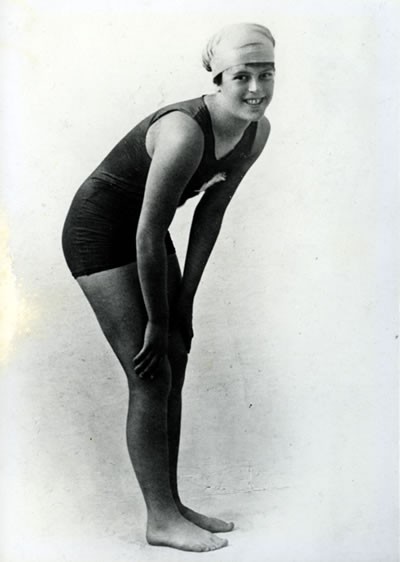
Violet in Antwerp
Violet Walrond was New Zealand’s first female Olympian. She was only 14 when selected and 15 when she swam at the 1920 Antwerp Games. Standing 1.6 m tall, she weighed just 48.5 kg.
Violet was part of New Zealand’s first official Olympic team. Her father Cecil (‘Tui’), who was also her swimming coach, was her chaperone and the unofficial coach of the team. Preparation was not ideal. The sea journey was delayed in Australia and South Africa, and the team arrived after nine weeks of travel with little chance for training. They had no team uniform – the men wore suits and Violet a cream frock. Only the fernleaves on their hatbands identified them as New Zealanders.
Auntie Vi
Violet’s great nephew Carl Walrond recalled that:
‘whenever I
visited Auckland in the early 1990s I would go and see Auntie Vi, who lived in St
Heliers. She would show me her swimming medals and old photos. When I left she told
me to “take as many poor man’s oranges as I wanted” from the
backyard tree. Laden with grapefruit, I marvelled at my father’s aunt, who in
her time was not only an Olympic athlete, but a beautiful young woman.’
The race venue was a cold murky canal with no lane ropes. Violet came third in her 100-m freestyle heat and fifth in the final. In the 300 m she was second in her heat and seventh in the final. Violet was the first Kiwi female to practise the ‘crawl’ (she had copied the style of the Wellington male champion, one of only two New Zealand men to have adopted the stroke).
At Antwerp only Violet and the American swimmers used the crawl. The winning Americans, Ethelda Bleibtrey and Irene Guest, told her she shouldn’t have used the stroke over the entire distance in the 300 m – but she didn’t know any other freestyle stroke. Violet’s kick was more propeller-like while the Americans had more of a scissor-type kick. The other competitors were still using the ‘trudgen’, which is now considered a slower stroke.
Following the Games, Violet came third in a 5-mile (8-km) race on the River Thames in London. Not bad for someone who had never swum further than 800 m before. In 1923 she won the 100-yards freestyle at the Australian Swimming Union championships in Sydney. Not long after that Tui Walrond decreed that both Violet and her younger sister Edna, who was also an accomplished swimmer and New Zealand’s top diver, would retire. Violet was 18, and although she disagreed, in those days young women had no say in such matters. Undoubtedly both she and Edna (as a diver or swimmer) would have been selected for the 1924 Paris Games.


Community contributions